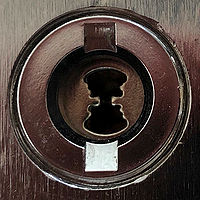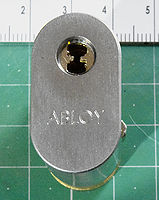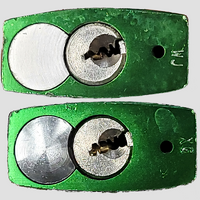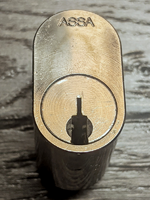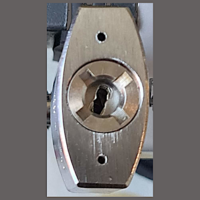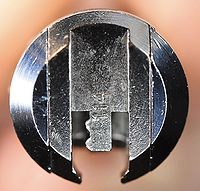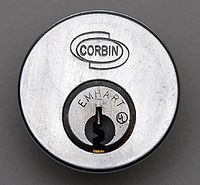Testing-mgsecure: Difference between revisions
| Line 510: | Line 510: | ||
== Belt | == Belt ranking content == | ||
The '''Belt Ranking system''' is a tiered classification developed and maintained by [[Lock Pickers United]] (LPU), a group of [[locksport]] experts and enthusiasts. It emulates the color-coded belt rankings commonly used in martial arts disciplines and functions primarily to codify achievements in [[lockpicking]] and related skills. The rankings provide a concrete framework for quantifying skill and progress in lockpicking/locksport. | |||
Belt ranks are defined by lists of qualifying locks, forms of documentation for picking, and other related challenges for more advanced belts. Participants submit documentation of their accomplishments for review ''(BY WHOM?)'' and are awarded belt rankings accordingly. | |||
The belt ranking system is used both as a means of comparison to other lockpickers as well as a set of milestones for evaluating one's personal progress and achievements. It creates a basic model of reputation management for participants and other people involved in locksport. An individual's belt ranking is also used by LPU to limit access to some resources on sensitive topics such as [[safecracking]]. | |||
Belt ranking classification is also used as a shorthand for lock difficulty, as each belt defines a list of locks of comparable complexity. Locks not on the list are frequently described by their "approximate" belt level. | |||
{| class="wikitable" style="" | {| class="wikitable" style="" | ||
|- | |- | ||
! style="text-align:left; padding:5px;" | Belt rank | ! style="text-align:left; padding:5px; width:65px;" | Belt rank | ||
! style="text-align:left; padding:5px;" colspan="3" | Qualifying lock examples | ! style="text-align:left; padding:5px;" colspan="3" | Qualifying lock examples | ||
! style="text-align:left; padding:5px;" | Additional requirement example | ! style="text-align:left; padding:5px;" | Additional requirement example | ||
Revision as of 18:29, 20 December 2022
This page being used for testing and development
Disassembly instructions edit
Original: To disassemble a double euro cylinder, use of a pinning shoe is the preferred method. Other possibility is to use a segmented follower, but that requires that both cores are pulled out a bit to allow a cam removal. Then a core should be rotated to approximately 4:30 or 7:30 o'clock position (135 degrees either clockwise or anti-clockwise) to prevent driver entering a gaps for the cam clutch. Then a segmented follower can be used to remove the core.
Proposed edit: The use of a pinning shoe is the preferred method for disassembling a double euro cylinder. Another method is to use a segmented follower. The c-clips retaining both cores must first be removed and then both cores can be pulled out slightly in order to remove the center cam. One core should be rotated to approximately 4:30 or 7:30 o'clock position -- 135 degrees either clockwise or counter-clockwise -- once the cam is removed. This allows the core to be removed without driver pins entering gaps for the cam clutch. At that point, a segmented follower can be used to remove the core.
Locks not intended for installation and use can be disassembled in a quick but destructive procedure. The cylinder housing itself can be cut in the middle using a hacksaw or grinder. The cam will no longer be held in place and can be removed. The resulting two cut half euro cylinders can then be disassembled as outlined above.
Larger gallery thumbnails (200px)
Classification Test
All lock listing
As of 12 December, 2022
- Abloy Classic
- Abloy Disklock
- Abloy Easy
- Abloy Exec
- Abloy Novel
- Abloy Profile
- Abloy Protec
- ABUS
- ABUS 34
- ABUS 55
- ABUS 64TI
- ABUS 72
- ABUS 75IB
- ABUS 80TI
- ABUS 83
- ABUS Diskus 25
- ABUS EC700
- ABUS Plus 88/50
- American Lock 1100 1200 1300
- American Lock 5200
- American Lock 747
- Anchor 810-1
- ASSA 10450
- ASSA 700
- ASSA 7241
- ASSA d12
- ASSA Desmo
- ASSA dp4400
- ASSA Twin 6000
- ASSA Twin Combi
- ASSA Twin V-10
- Baton
- BiLock FG
- CISA 220
- CISA C2000
- CISA C3000
- Corbin Emhart
- DeGuard Dimple Lock
- DOM Plura
- DOM RS5
- DOM Sigma
- Duo
- Everest 29 SL Primus XP
- EVVA 3KS
- EVVA DPI
- EVVA DPS
- EVVA DUAL
- EVVA ICS
- EVVA MCS
- FAB 1*
- FAB 100
- FAB 1000
- FAB 2**/3***
- FAB 200
- FAB 2000
- FAB 3***/4****
- FAB 50
- FAB Control
- FAB Dynamic
- FAB NZS3
- FAB Variant
- Fichet 480
- Fichet 787
- Fichet F3D
- Goal D9
- Goal P
- Goal V18
- Goal Z
- Hi-Shear LK 1200
- IKON TK5
- IKON WSW
- Ingersoll CS700
- KABA Gemini
- Kale Kilit 164 BNE
- Kryptonite 851219
- Kwikset Classic
- Kwikset Smart Key
- La Gard 1985
- LaGard 2200
- La Gard 3390
- LIPS Octro
- Lockwood 110 series
- Lockwood 334 series
- Lockwood Twin
- Mark IV Manifoil
- Master Lock No 1
- Master Lock No 130
- Master Lock No 140
- Master Lock No 141
- Master Lock No 142
- Master Lock No 150
- Master Lock No 175
- Master Lock No 2
- Master Lock No 22
- Master Lock No 2240
- Master Lock No 3
- Master Lock No 4
- Master Lock No 410
- Master Lock No 605
- Master Lock No 975
- Medeco Biaxial
- Medeco BiLevel
- Medeco Duracam
- Medeco KeyMark
- Medeco M3
- Medeco M4
- Medeco Original
- Miracle Magnetic
- MIWA 3800
- MIWA EC
- MIWA VM99
- Mul-T-Lock Interactive
- Mul-T-Lock Interactive+
- NATO Mersey
- Nemef NF2
- Nemef NF3
- Nemef NF4
- Pacific Lock 100G
- PACLOCK 90A
- Robotic Key System
- Rosengrens RKL-10
- S&G 6804
- S&G 8077
- S&G 8088
- S&G 8430
- S&G 8500
- S&G 951
- Sargent Signature
- Schlage Everest
- Schlage Everest Primus
- Schlage Primus
- Schlage SecureKey
- Scorpion CX-5
- Sesamee 55230
- Sphero
- StealthKey Cylinder S14
- TOKOZ Pro 300
- TOKOZ Pro 400
- WEST 916
- WEST 917
- Wordlock CL441-BK
- Yale 324
- Yale 850
- Yale Junior Disc Tumbler 603
- Yale U.S.N. Electric
- Yardeni 6
Belt ranking content
The Belt Ranking system is a tiered classification developed and maintained by Lock Pickers United (LPU), a group of locksport experts and enthusiasts. It emulates the color-coded belt rankings commonly used in martial arts disciplines and functions primarily to codify achievements in lockpicking and related skills. The rankings provide a concrete framework for quantifying skill and progress in lockpicking/locksport.
Belt ranks are defined by lists of qualifying locks, forms of documentation for picking, and other related challenges for more advanced belts. Participants submit documentation of their accomplishments for review (BY WHOM?) and are awarded belt rankings accordingly.
The belt ranking system is used both as a means of comparison to other lockpickers as well as a set of milestones for evaluating one's personal progress and achievements. It creates a basic model of reputation management for participants and other people involved in locksport. An individual's belt ranking is also used by LPU to limit access to some resources on sensitive topics such as safecracking.
Belt ranking classification is also used as a shorthand for lock difficulty, as each belt defines a list of locks of comparable complexity. Locks not on the list are frequently described by their "approximate" belt level.
| Belt rank | Qualifying lock examples | Additional requirement example | ||
|---|---|---|---|---|
| White | "Open any lock with any tool" | |||
| Yellow | ABUS 55/30 | Master Lock No 140 | Kwikset Classic | |
| Orange | ABUS 65/40 | Master Lock No 150 | FAB 100 | |
| Green | ABUS 72/40 | Master Lock No 410 | American Lock 1100 | Show ability to gut & reassemble locks |
| Blue | ASSA 700 | DeGuard Dimple Lock | Medeco BiLevel | Build and share a challenge lock |
| Purple | ASSA Desmo | Mul-T-Lock Interactive | Schlage Everest | Demonstrate history of helping new pickers |
| Brown | ASSA d12 | KABA Gemini | WEST 916 | Make at least one specialized tool |
| Red | Abloy Classic | ABUS EC700 | EVVA 3KS | Mentor another advanced picker in picking a difficult lock |
| Black | Abloy Protec | ASSA Twin 6000 | Goal V18 | Detailed requirements for advanced skills or "Master's Projects" |
| This list is for reference only. The current, official list of locks and requirements is maintained by LPU administrators[1][2] | ||||
Sortable, formatted table
| Belt | Make | Model | Notes |
|---|---|---|---|
| Orange | ABUS | ABUS 55 | |
| Purple | Mul-T-Lock | Mul-T-Lock Interactive | |
| Brown | ASSA | ASSA d12 / ASSA P600 | |
| Brown | Goal | Goal D9 | |
| Red | Goal | Goal V18 / Goal GP | (< 14 pins) |
| Black | Goal | Goal Grand V | |
| Black | Goal | Goal V18 / Goal GP | (≥ 14 pins) |
| Black | Goal | Goal Z | (<2 standard drivers) |


